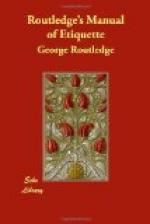As we have long ago discarded the picturesque from bonnets, and the famous “chapeau de paille” has been laid aside, there is an advantage in the fact that the present style is unobtrusive; and strong-minded women who cling tenaciously to their beloved old coal-scuttle shape, and deride the present fashion, indignantly exclaiming against it, “Call that thing a bonnet, indeed?” certainly tempts us to reply to their prejudiced and absurd reflections, “Physician, heal thyself;” for if there is one thing more ugly than another, it is the old-fashioned bonnet with crown, curtain, and poke, to which a few old maids rigidly adhere—just as Quakeresses do to their hideous and antiquated style. There is a kind of self-righteousness in the protests of these ladies, with which we confess that we have no sympathy. We do not mean to recommend them to adopt the bonnet of a girl of eighteen, but we do advise them to conform to the fashion of the day, and wear a modified edition of the present and prevailing costume.
It is remarkable how straw always retains its hold as a material for bonnets. A straw bonnet, is, however, a more expensive article than one of tulle; but then it is more enduring, and better suited for country wear. There is also another advantage in straw: it never looks vulgar. A country lass in a bonnet of silk, or lace, or tulle, does not look one-half as well as one in a straw bonnet, neatly trimmed. Straw is becoming to persons of all ages and of every station. It makes a vulgar woman look less vulgar, and the lady more refined. Though common, it is never so in an offensive sense.
Caps have become an important item, from the fact that women of all ages wear something of the kind. The young girl who has passed from girlhood into matrimony, considers it necessary that some of those little caps made of lace and ribbons and which have such a coquettish look about them, should form part of her trousseau. She is as glad to exercise her new privilege of wearing a cap as an undergraduate is of wearing his cap and gown. It is a sign that she has passed to what she considers the higher state, although she knows that there are many high authorities for the contrary; but she remembers that “doctors differ,” and she hails her privilege as one to which she has been always taught to look forward.
What can be more becoming than some of those jaunty caps which seem to mock at age? Here, again, we have a manifest improvement in the head-gear of ancient times.
Think of the turbans, the gigantic hats and caps of blonde which were made to stand erect by means of wire, and which surrounded the face like fans at full stretch, or (more gracious simile) like the nimbus round the head of a mediaeval saint.




